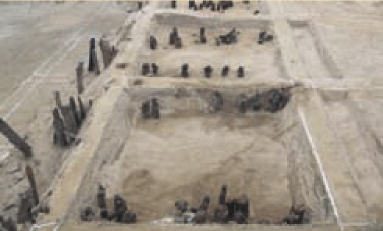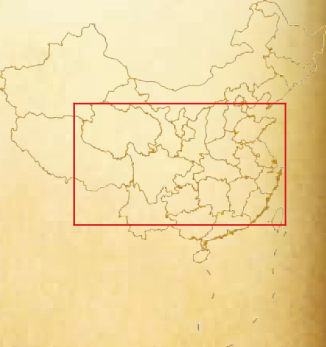
Part of the Weiqiao bridge relics site in Xi'an, Shaanxi province.[CHINA DAILY]
7. Weiqiao bridge relics from the Western Han Dynasty (206 BC-AD 24) to the Eastern Han Dynasty (AD 25-220), Xi'an, Shaanxi province
Evidence of seven bridges was found on what was once the course of the Weihe River. Strangely, five of them are located within a short distance of 400 meters. The longest one was 880 meters long, and believed to be the world's longest bridge built with wooden beams and columns. These were also the first bridges from Chang'an (today's Xi'an) westward via the Silk Road.
Numerous vestiges of repair were observed, ranging for several successive dynasties. Discovery of 17th-century coins in the riverbed proves the Weihe River did not change its current course earlier than that period of time.
"The discovery fills the academic void on ancient bridges of Chang'an, the capital of so many dynasties in China," says Liu Rui, a deputy researcher with the Institute of Archaeology under the Chinese Academy of Social Sciences. "It was where many historic incidents occurred, and the discovery will also help us better understand how the local natural environment changed in ancient times."

CHINA DAILY
A pottery figurine from the Tomb of Emperor Yang in Yangzhou, Jiangsu province.
8. Tomb of Emperor Yang of the Sui Dynasty (AD 581-618), Yangzhou, Jiangsu province
The last emperor of the Sui Dynasty is probably one of the most notorious tyrants in Chinese history, though recent academic studies have portrayed a more neutral image of this controversial figure, who ordered the construction of the Grand Canal.
The two tombs were believed to belong to this emperor and his queen, due to the unearthed remains, epigraphy and valuable sacrificial items.
About 600 sacrificial items were discovered, among which some have strong local characteristics particular to Yangzhou. They are different from those from the Sui Dynasty's capital city of Daxing (today's Xi'an). One 13-knot gold-and-jade belt is the only complete belt of its type ever found in China. It is an example of the highest-level belt available in that time period. Bronze bells from the Sui Dynasty were discovered for the first time.
"The findings prove relevant historical recordings and offer much first-hand information about high-level tombs in that period of time," says Shu Jiaping, head of the Yangzhou Municipal Institute of Archaeology. "It will greatly enrich the cultural significance of Yangzhou."
9. Shiqu rock engravings of the Tubo Kingdom (7th to 9th century), Shiqu county, Sichuan province
Three rock engravings from the Tubo Kingdom were found in three different locations in Shiqu county. The one found on the Xubashan Mountain site, which consisted of 13 engravings, is the most important. It features a large number of Buddhist images and totems that provide valuable information. The documents, written in ancient Tibetan, also contain information that helps identify these engravings' ages.
One engraving is a record of precious Buddhist eulogies written in ancient Tibetan and is one the best-preserved relics of its type ever found.
"The location of the ancient route between the Tubo Kingdom and the Tang Empire was ambiguous due to the lack of records, despite the discovery of some scattered relics in the nearby area," Gao Dalun, head of the Sichuan Provincial Cultural Relics and Research Institute, explains.
"However, these rock engravings give us new information. We've got much more information on bilateral relations between the Tang and Tubo, as well as the history of Buddhism in the area. It also creates a model for protection of cultural relics in areas inhabited by non-Han ethnic groups."
10. Nanyao porcelain kiln relics of the Tang Dynasty (AD 608-907), Jingdezhen, Jiangxi province
The site is spread over 30,000 square meters and is among the biggest ancient porcelain kiln relics in the province. One 78.8-meter-long kiln is the longest Tang Dynasty kiln of its type ever found.
The workshop dates back to 1,200 years ago. Porcelain production in Jingdezhen, considered to be ancient China's "porcelain capital", is said to have begun 2,000 years ago, a date suggested by historical records. Until the finding of the Nanyao site, however, the porcelain production in Jingdezhen can only be archaeologically dated to 1,000 years ago.
"These kiln relics, the earliest ever discovered in Jingdezhen, are an important supplement of orthodox history and help us determine how the porcelain industry developed here," says Zhang Wenjiang, a researcher with the Jiangxi Provincial Institute of Archaeology.
"We also found a crucial file on the overall development of the porcelain industry in the Tang Dynasty."

CHINA DAILY
We recommend:
